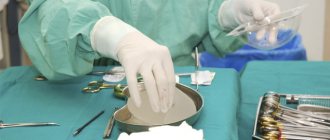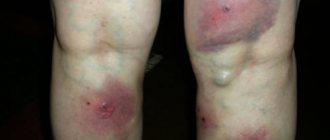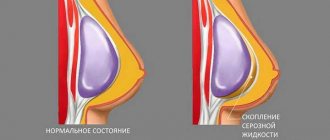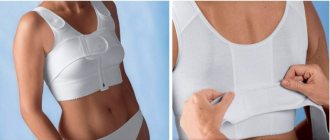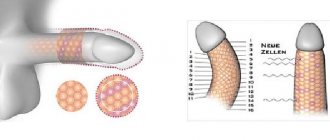Rehabilitation after breast correction involves some restrictions, which are gradually removed during 6 months of recovery, so every woman should know what not to do after mammoplasty. After all, the flawless and desired result of aesthetic surgery is a joint work of the plastic surgeon and the patient. It is extremely important to strictly follow all the doctor’s recommendations and consult with him on basic issues: when, after breast augmentation, can you remove the compression underwear and replace it with a new beautiful bra with underwire? What medications should I take? How to care for your skin and when can you resume sports? Unfortunately, there are no unambiguous and generalized answers to these questions, since the course of rehabilitation is extremely individual. Specialists of the clinic named after. N.I. Pirogov is always in touch and guides her patients from the moment of initial consultation until the successful completion of rehabilitation.
Definition
Ripping after mammoplasty is a complication characterized by the formation of small folds, “waves” or “ripples” on the breast.
It represents a visual manifestation of the implant.
When the implant is positioned vertically, its upper part rolls into the lower part, and folds form at the top (typical of saline implants). When the skin is over-tensioned, these folds begin to appear.
Ripping may not appear when the glands are in a quiet position and can only be detected when the body is tilted or while walking.
A defect can occur due to the physiological characteristics of the body, insufficient volume of skin, incorrectly selected implants, violation of surgical technique, etc.
The likelihood of ripping directly depends on the size of the selected implants. The larger they are, the sooner a defect will occur.
Infection
Any operation is associated with infection. The first factor is the qualifications of the surgeon and his professional work experience. The second factor is the patient’s failure to comply with hygiene requirements after surgery.
A lump in the breast that appears after mammoplasty can be mistaken for signs of mastopathy.
This disease is diagnosed only after examination by a specialist and examination. After the procedure, it is eliminated by changing the implant if discomfort and pain appear in the chest.
Cosmetologist, dermatologist, trichologist
Kalinina Olga Alexandrovna
4 years of experience
Accompanied by a temperature above 38 degrees, redness and purulent discharge. Antibiotics and antiseptic drugs are prescribed, and in difficult cases, the endoprosthesis is removed or replaced.
Why does it appear
Often, a similar effect appears after surgery, when the swelling subsides, but the skin still remains stretched, poorly contracted and gathers in folds. In this case, implants have nothing to do with it; this is a temporary phenomenon.
There are several factors that influence the risk of this complication:
- volume and elasticity of the skin and soft tissues;
- type and size of implant;
- place and technique of administration.
“Waves” most likely will not appear or will be barely noticeable if the volume of the skin is sufficient to properly cover the implant.
This is why ripping appears more often in petite women with a thin layer of fat and small mammary glands.
In obese patients with a pronounced layer of subcutaneous fat and initially voluminous breasts, this problem, on the contrary, does not exist.
In general, it is believed that the more implants are selected, the higher the risk of ripping.
The location of the prosthesis plays an important role. Submuscular placement of the implant (i.e., under the muscle) is preferable.
Thanks to this, a larger volume of soft tissue is formed over the prosthesis, and the muscles themselves have their own tone, which also helps hide the defect.
Since the muscle only covers half or 2/3 of the top of the implant, it is still possible for ripples to form in the area of the lower gland fold.
Photo: Ripling
But this place itself is hardly noticeable, and even with deep probing you can feel something, but not see anything special. That is why a little ripping is perceived quite normally here.
The pectoral muscles are usually well developed in the center and become thinner and flatter towards the outer border of the rib cage.
Therefore, when the prosthesis is inserted under the muscle, the outer edge of the tissue volume may not be enough, and ripples from the side become noticeable (especially when bending). If such a defect is unacceptable, you will have to opt for smaller implants.
Ideally, the width of the prosthesis should be less than the diameter of the mammary glands before mammoplasty.
The “washboard effect” often occurs when placing saline implants that are filled with saline solution.
In addition, in addition to the waves along the edges of the prosthesis, where there is a lack of native tissue, such implants give the effect of ripples over the entire surface of the gland.
This is the result of free movement of fluid inside the prosthesis when it is not filled enough. Ripping is especially pronounced when the implant is placed over the pectoral muscle.
Gel implants do not have this drawback, which is why most clinics now use them.
Regarding the surface, rough implants, compared to smooth ones, increase the risk of ripples.
This is due to the fact that your own tissues seem to “stick” to the textured surface.
But this point is relevant only when installing the prosthesis over the pectoral muscle, and not when inserting it subpectorally.
Preventive measures
To minimize the risk of possible complications, you will first need to take a responsible approach to choosing a plastic surgeon.
The specialist must have the appropriate qualifications, have a diploma and certificates confirming regular training.
This will eliminate problems that most often arise due to incorrect actions by the doctor during mammoplasty.
What can be done for prevention:
- wear shapewear for the entire recommended time (1-3 months);
- reduce physical activity to a minimum;
- do not lift heavy objects;
- carefully treat the seam and chest area with antiseptic agents;
- do not injure the mammary glands;
- regularly visit a doctor until the tissues are completely healed;
- During the entire rehabilitation period you should not drink alcohol or smoke;
- Take antibacterial agents after surgery as prescribed by the doctor.
With the right actions during the rehabilitation period after mammoplasty, most serious complications can be avoided.
Of course, some problems may arise due to the individual characteristics of the body. But a good doctor will definitely warn about all possible troubles, based on the medical history of a particular patient.
The video provides additional information on the topic of the article.
What does ripping look like after mammoplasty?
Ripping looks as if your fingers ran across the iron and small “grooves” were left on the surface.
With a small amount of tissue, wrinkled breasts do not look particularly aesthetically pleasing.
The washboard effect is not a fixed defect. This means that it is usually invisible, but can be visualized while walking or bending over.
The ripples can be small and unnoticeable to others and can only be felt when running your hand over the skin.
Some women don't mind ripping at all if they find it acceptable. But for others, the defect becomes a real problem, which can only be solved surgically.
Photo: Implant shrinkage
Decreased ability to breastfeed
Breastfeeding issues are discussed with the surgeon in the preparatory period. Both saline and silicone endoprostheses do not have a negative effect on pregnancy and fetal development, even in the event of rupture.
With periariolar access (through the isola incision), the ability to breastfeed is significantly reduced or completely lost, as the ducts are crossed.
With submarinal (under the breast) and axillary access, the mammary gland is not injured. But if there were complications, the risk of impaired ability to breastfeed remains.
After breastfeeding, at least 6 months later, you can begin preparing for mammoplasty.
Where is it formed
If the implant is inserted under the pectoral muscle, waves will most likely appear at the edges of the chest, since there are no muscles there to cover the prosthesis.
As you lean forward, the ripples become more noticeable as they pull on the skin.
Ripping occurs more often with the introduction of saline implants, especially if there is little natural fatty tissue in the mammary glands.
This effect is explained by the chemical properties of the water-salt solution that fills the prosthesis.
When placing gel implants, ripping is rarely a concern, since the viscous gel holds its shape well.
If implants are too large, the bust may take on a rectangular shape instead of a beautiful smooth outline. And in the area where the muscles cannot cover the prosthesis, pronounced skin wrinkling will occur.
Read when you will have your first period after mammoplasty.
What should breast care be like after mammoplasty? Details here.
Breast change
After surgery, breasts may change shape and become denser. This change is called capsular contracture.
Essentially, a capsule of fibrous connective tissue is formed around the implant, which thickens and thickens over time. Normally, the capsule is very thin and measures 1/10 of a millimeter. But with capsular contracture, the capsule grows to 2-3 mm or more.
Why can our articles be trusted?
We make health information clear, accessible and relevant.
- All articles are checked by practicing doctors.
- We take scientific literature and the latest research as a basis.
- We publish detailed articles that answer all questions.
It gradually squeezes and compresses the implant, which leads to its deformation, and therefore to a change in the shape of the breast and to pain. In severe situations, it leads to atrophic changes in breast tissue.
If capsular contracture is detected, corrective surgery is performed. The implant is changed and the capsule is removed.
What to do
There are ways to eliminate the problem, but they are all surgical. Therefore, it is better to try to avoid a defect during the initial consultation and surgery by choosing suitable implants and the method of their insertion.
Previously, ripping was eliminated by replacing saline implants with gel ones or by moving them under the mammary gland if they were installed above it (under the mammary glands).
Now, several solutions are available to solve this problem.
Implants can be replaced with high-density gel prostheses; they can be installed under the chest muscles; a dermal matrix can be introduced into the area where this complication is formed, which will hide the waves.
In some cases, the defect can be eliminated by introducing your own fat layer into the problem area.
If ripping is caused by the installation of a saline implant or its insertion above the pectoral muscle, the best solution is to repeat the operation and replace the saline prosthesis with a gel one (in the first case) and installing an implant under the muscle (in the second).
If the skin itself is thin and there is not enough gland volume, you can pay attention to the introduction of a dermal matrix (Alloderm). This technique will help reduce wrinkles.
Alternatively, you can transplant fat tissue, which will give your own tissues additional volume.
Another solution to the problem is to replace the prosthesis with a smaller one. But if you absolutely don’t want to change the size, it’s better to just leave everything as it is and not pay attention to the defect.
Scarring
Immediately after the operation, the surgeon applies a special plaster to the scar. It makes it possible to maintain body hygiene at first.
It is important to allow scars and cicatrices to heal quietly in the first months. Surgeons recommend:
- do not scratch the scar, but let it heal and form;
- smear the formed scar with a special silicone gel;
- stick on silicone strips, which allow the skin to breathe and do not allow water to pass through, and also visually make the scar invisible;
- do not visit swimming pools, postpone a trip to the sea;
- do not load the chest area, scars should not stretch.
Compression garments after mammoplasty
Mammoplasty is a surgical intervention, so the patient needs a rehabilitation period.
After a few months, the incision line will not be visible at all. But if a woman’s visible part has an unaesthetic appearance and this bothers her, plastic surgery has ways to correct this:
- excision of a scar or scar;
- grinding.
There cannot be the same time period until complete recovery. Therefore, if the scar is red, you need to wait until it turns white. Otherwise, you can get a keloid.
Risks and complications
In general, it is believed that ripping is not a classic surgical complication.
However, focusing on the possible dissatisfaction of patients, plastic surgeons try, whenever possible, to make any attempts to minimize the possibility of skin ripples.
This is more an aesthetic problem than a medical one, so, as a rule, there is no talk of serious risks and complications.
Not every patient is ready for a second operation, so most often everything is left as is.
Ripping can hardly be called a complication, since waves do not always appear, but only when the body bends forward or during active movements. It may be visually faintly noticeable, and only the woman herself can feel the unevenness.
Find out why breast pain occurs after mammoplasty.
Do scars appear after mammoplasty? Read more.
How long after mammoplasty can I play sports? Details here.
Is it possible to warn?
There are no specific recommendations regarding the prevention of visual changes. The correctness of the consultation and the skill of the specialist who will perform the operation play an important role. He will select an implant that will be ideal for the patient, which will help prevent the problem. It is important that during the consultation the patient learns that the use of implants that are too large and inappropriate for her body type may lead to similar visual defects in the future. Only by assessing her physical characteristics and correlating them with the volume of implants can a woman make the right choice.
Swelling of the abdomen
Swelling is a normal reaction of the body to surgery.
Sutures after mammoplasty
Suturing after mammoplasty is a standard final surgical procedure.
But abdominal swelling after mammoplasty is not observed in all patients. Often, an unpleasant symptom occurs when access during surgery is carried out under the breast.
It appears gradually. Swelling immediately after a breast augmentation procedure is observed only in the mammary glands. After 1-3 days it drops onto its stomach. In appearance, it is swollen; when pressed, marks may remain.
The color of the skin changes only when there is bleeding. In this case, bruises and hematomas appear on the abdomen.
Unsuccessful breast surgery can lead to swelling. In this case, the symptoms will be pronounced, they will constantly increase and worsen.
To relieve swelling, it is recommended to apply cold to the abdomen, wear compression garments after surgery, and eat right. In the first days after surgery, you should not take a hot bath, shower, or visit a sauna or bathhouse. In severe cases, it is necessary to use homeopathic remedies in the form of creams to relieve swelling.
Rotation of the implant
As a rule, this complication occurs when installing an anatomically shaped implant. When a teardrop implant is placed in the correct size pocket to ensure a secure fit, the risk of implant failure is reduced to zero. In the case where there is free space, the surgeon, to prevent the possibility of the implant turning over, must use drainage to eliminate it. Despite frequent mention on the Internet, this complication is quite rare.
Silicone implant rupture
The complication is accompanied by the release of silicone filler from the shell. The danger of this complication lies in the impossibility of timely diagnosis. Silicone gel, unlike saline solution, penetrates the body tissues much more slowly.
Once outside the membrane, it causes inflammatory processes and the formation of capsular contracture.
Treatment consists of surgical removal of the implant with the resulting fibrous capsule and installation of a new one.
Read more about implant rupture here
